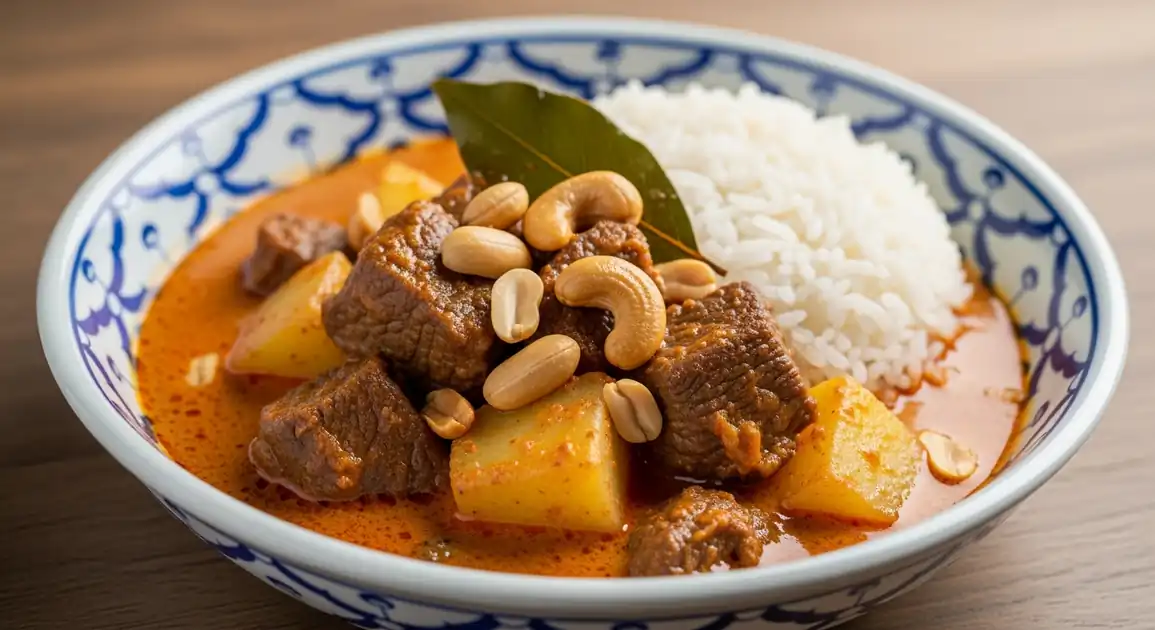Massaman Curry
แกงมัสมั่น

Description
In Bangkok, Massaman Curry is widely available, from street-side 'khao gaeng' stalls to renowned heritage restaurants and upscale hotel dining. You can find diverse interpretations, including classic beef, popular chicken, and vegetarian options, particularly in areas catering to tourists and expats, as well as traditional Muslim neighborhoods.
Dietary Information
Serving information
Serving style
Served with jasmine rice in virtually all settings. Portion sizes may vary from single servings at stalls to larger bowls for sharing in restaurants.
Quick facts
Local eateries & stalls: 10 AM - 4 PM or later. Restaurants: 11 AM - 10 PM generally.
Safety Tips
What to Look For
-
Served piping hot
Ensures the curry is freshly cooked or properly reheated to kill potential bacteria, especially important for meat dishes.
-
Tender meat consistency
Indicates the meat has been cooked thoroughly for a sufficient time, making it safe and palatable.
-
Rich aroma of spices and coconut
A good sign of fresh ingredients and proper preparation. Lack of aroma might suggest an old or poorly made batch.
-
Visible presence of key ingredients
Look for potatoes, onions, and peanuts/cashews which are characteristic of authentic Massaman.
-
Clean serving area and utensils
Observe the general hygiene of the restaurant or stall, including serving spoons and storage of ingredients.
-
Clear communication about ingredients (allergens)
Staff should be able to answer basic questions about ingredients, especially allergens like peanuts, tree nuts, fish sauce, and shrimp paste.
What to avoid
-
Lukewarm curry
Curry kept at improper temperatures is a breeding ground for bacteria. Insist on hot curry.
-
Meat that looks dry, tough, or old
Suggests improper cooking, reheating, or that the curry has been sitting for too long.
-
Excessive oil separation
While some oil separation is normal and desired ('cracked' coconut cream), a very thick layer of old-looking oil might indicate the curry is old or has been reheated multiple times improperly.
-
Unclean serving spoons or communal pots
Risk of cross-contamination from dirty utensils or customers handling spoons improperly.
-
Vendors unable/unwilling to discuss ingredients
Especially concerning for allergy sufferers. Choose vendors who can provide basic information.
Price information
Price range
Budget tips
- Seek out 'khao gaeng' vendors in office districts or local markets for portions around 70-100 THB.
- Food courts in malls like MBK or Terminal 21 offer competitive prices (120-180 THB).
- Muslim-run eateries in areas like Phra Nakhon or Bang Rak often provide authentic taste at reasonable prices.
Value indicators
- Slow-cooked, tender meat.
- Complex, aromatic spice profile without being overly sweet.
- Good balance of sauce, meat, potatoes, and peanuts.
- Served hot and fresh.
Where to Find This Dish
Bang Rak
Known for its mix of old eateries and Muslim influences, find good Massaman in local restaurants here.
Near Robinson Bang Rak, Charoen Krung Road
Lunch, Dinner
Phra Nakhon (Old City)
Home to several well-regarded traditional Thai restaurants, some specializing in royal cuisine influenced dishes like Massaman.
Near Khao San Road (but venture further), Maharat Road
Lunch, Dinner
Sukhumvit (Expat/Tourist Areas)
Many restaurants along Sukhumvit Road and its side streets ('sois') offer Massaman, often tailored slightly for foreign palates.
Soi 11, Soi 38 (food stalls), EmQuartier/Emporium food courts
Lunch, Dinner
Or Tor Kor Market
Upscale food market with high-quality cooked food stalls, including reliable curry vendors.
Adjacent to Chatuchak Weekend Market
Late Morning, Lunchtime
Vendor Tips
- Look for signs advertising 'อาหารตามสั่ง' (Ahaan Tam Sang - food made to order) for freshly prepared curry.
- Specialized 'Khao Gaeng' shops often have multiple curries simmering; Massaman might be one.
- In tourist zones, specify if you want authentic Thai taste ('phet nit noi' - a little spicy) as default might be very mild.
How to Order
Regional Variations
-
Massaman Noodles
(ก๋วยเตี๋ยวแกงมัสมั่น (Kuay Teow Gaeng Massaman))
An occasional fusion dish where egg noodles or rice noodles are served with Massaman curry sauce instead of rice.
-
Upscale Versions
(มัสมั่นชาววัง (Massaman Chao Wang - Royal Style))
Some high-end restaurants offer refined versions, potentially using premium beef cuts (like shank) or slightly different spice nuances based on older recipes.
Cultural context
History
Massaman Curry's origins are traced to 17th century Siam (Thailand) through Persian merchants and envoys, possibly influencing the royal court cuisine. The name 'Massaman' is thought to derive from 'Musalman,' an old Persian word for Muslim, highlighting its connection to Muslim traders and Southern Thai Muslim communities. The use of dry spices like cardamom and cinnamon distinguishes it from typical Thai curries and points to foreign influences. It has since become a beloved dish throughout Thailand and internationally recognized.
Local significance
In Bangkok, Massaman represents a bridge between traditional Thai cuisine and historical foreign influences, available across all levels of dining.
Eating customs
- Consumed with rice as part of a larger meal with several shared dishes.
- Commonly ordered by those seeking a milder curry option.